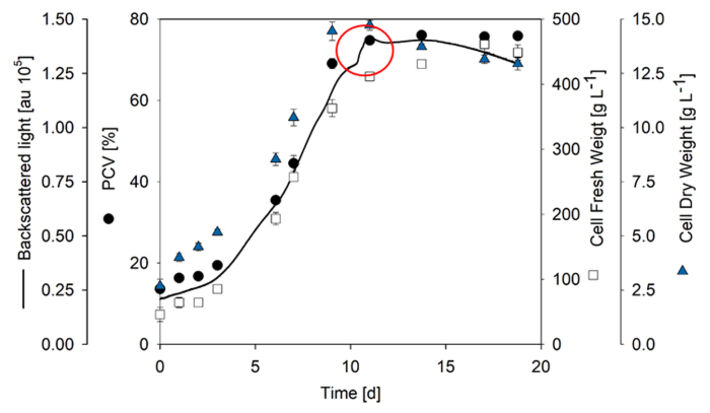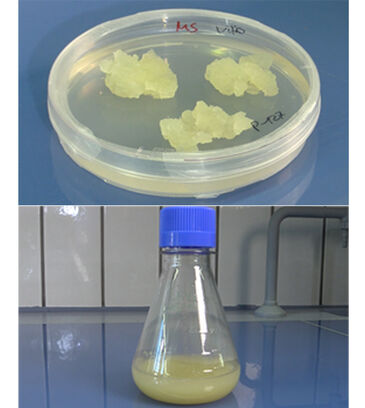Watch tutorials, webinars and informative videos about PreSens optical sensor systems.
Interpreting SFR vario Online Data Gathered in Plant Cell Suspension Culture
Characterization of plant cell lines for successful production processes
R. W. Maschke1, B. Pretzner2, G. T. John3, D. Eibl1
1Zurich University of Applied Sciences, Institute of Chemistry and Biotechnology, Wädenswil, Switzerland
2Werum IT Solutions GmbH, Vienna, Austria
3PreSens Precision Sensing GmbH, Regensburg, Germany
We used the SFR vario for online monitoring in plant cell suspension culture at shake flask scale. By comparing the online gathered data with offline determined values, we were able to confirm, that the SFR vario backscattered light measurement is ideal to predict biomass development. Furthermore, the online pH and oxygen measurements gave insight in different metabolic processes during the whole cultivation.
Evaluation of cell lines or culture optimization for biopharmaceutical production processes is often performed in small-scale systems like shake flasks. However, plant cell suspension cultures can grow to high cell volumes, which leads to increasing viscosity and problems with mixing and oxygen transfer in the culture vessel. Therefore, it is important to monitor vital culture parameters, to ensure safe production and reproducibility.
We used the SFR vario monitoring unit to measure oxygen, pH and biomass in Vitis vinifera cv. Uva Italia cell suspension culture. We evaluated the method of backscattered light measurement for biomass determination and how continuous online measurements can be interpreted and used of culture evaluation at shake flask scale.
Material & Methods
V. vinifera [1] suspension cell culture in Murashige and Skoog medium with 30 gL-1 sucrose was performed in 250 mL or 500 mL unbaffled shake flasks (40 % filling volume, 120 rpm, 50 mm shaking amplitude) at 26 °C. The SFR vario was used for continuous O2, pH and backscattered light (biomass) measurements. The measurement angle for biomass measurements was not adjusted. Fructose, glucose and sucrose concentrations were determined by HPLC and added up to get the total sugar concentration. The packed cell volume (PCV), cell dry weight and cell fresh weight were determined offline for comparison to the online data. Data collection and evaluation were carried out using the data analysis management system inCyght by Werum IT Solutions.
Online & Offline Measurements in Plant Cell Suspension Culture
In Fig. 2 online recorded backscattered light measurement compared to offline gathered biomass data in V. vinifera cell suspension culture is plotted. Backscattered light measurements show a continuous increase in biomass reaching a maximum after 10 days. The same biomass development trend can be seen in the offline data. At 10 days of cultivation the online data also reveal a process event that could not be detected in the offline measurements. Online gathered pH and oxygen data give further information on process events (see Fig. 3).

The change in pH indicates the uptake of different nitrogen species (ammonia uptake leads to a pH decrease, and at low pH nitrate uptake is preferred, which leads to subsequent pH increase [2]). This is typical in plant cell suspension culture and a good indicator, that the culture is growing well. The fluctuating course of dissolved oxygen measurements indicates the successive consumption of different carbon sources (blue arrows in Fig. 3). The complete depletion of carbon sources can be seen in a strong drop in oxygen content after 10 days of cultivation. At the same time the backscattered light measurements show that maximum biomass is reached.

The backscattered light signal can be calibrated to show biomass values in e.g. OD600 or cell dry weight. Fig. 4A shows a culture run in a 500 mL flask, where fresh media was added after 5 days. The backscattered light signal was calibrated with data collected in a 250 mL flask and is showing online measured cell dry weight, which we compared to offline measured cell dry and cell fresh weight. The correlation (Fig. 4B) shows that the calibrated online signal gives an ideal prediction of the actual cell dry weight (R2 = 0.983).

Conclusion
Our evaluation of the SFR vario monitoring system showed that the optical biomass determination via backscattered light measurements delivers good results in plant cell suspension culture. Furthermore, the combined oxygen, pH and biomass data measured with SFR vario gives insight in metabolic events, which cannot be detected with offline measurements. The real-time information provided by SFR vario allows us to verify proper culture performance early on during the process and gives accurate data about cell growth.
Reference
[1] Cuperus, F. S.: Influence of UV-B radiation on quality determing compounds in must and wine and suspension cell cultures of Vitis vinifera, ETH Zürich,phdthesis, 2007. http://dx.doi.org/10.3929/ethz-a-005347787. – DOI 10.3929/ethz–a–005347787
[2] E. F. George and G.-J. Klerk, “The components of Plant Tissue Culture Media I: Macro- and Micronutrients”, Plant Propagation by Tissue Culture, 3rd Edition, 2008
This project was funded by the European Union within the EuroStars Framework (Project ID 11 795).



